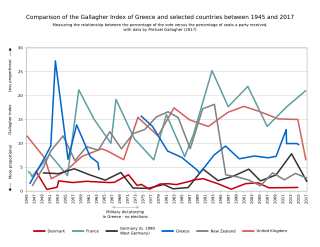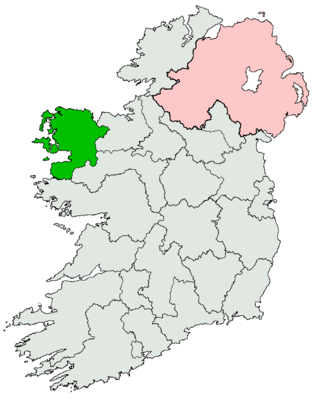Related Research Articles

The Gallagher index measures an electoral system's relative disproportionality between votes received and seats in a legislature. As such, it measures the difference between the percentage of votes each party gets and the percentage of seats each party gets in the resulting legislature, and it also measures this disproportionality from all parties collectively in any one given election. That collective disproportionality from the election is given a precise score, which can then be used in comparing various levels of proportionality among various elections from various electoral systems. The Gallagher index is a statistical analysis methodology utilised within political science, notably the branch of psephology.
Monaghan was a parliamentary constituency represented in Dáil Éireann, the lower house of the Irish parliament or Oireachtas from 1921 to 1977. The constituency elected 3 deputies to the Dáil, on the system of proportional representation by means of the single transferable vote (PR-STV).
A vocational panel is any of five lists of candidates from which are elected a total of 43 of the 60 senators in Seanad Éireann, the upper house of the Oireachtas (parliament) of Ireland. Each panel corresponds to a grouping of "interests and services" of which candidates are required to have "knowledge and practical experience". The panels are nominated partly by Oireachtas members and partly by vocational organisations. From each panel, between five and eleven senators are elected indirectly, by Oireachtas members and local councillors, using the single transferable vote. The broad requirements are specified by Article 18 of the Constitution of Ireland and the implementation details by acts of the Oireachtas, principally the Seanad Electoral Act 1947, and associated statutory instruments.
Cork West was a parliamentary constituency represented in Dáil Éireann, the lower house of the Irish parliament or Oireachtas from 1923 to 1961. The constituency elected 5 deputies to the Dáil, on the system of proportional representation by means of the single transferable vote (PR-STV).

Kildare–Wicklow was a parliamentary constituency represented in Dáil Éireann, the lower house of the Irish parliament or Oireachtas from 1921 to 1923. The constituency elected 5 deputies to the Dáil, on the system of proportional representation by means of the single transferable vote (PR-STV).
Kilkenny was a parliamentary constituency represented in Dáil Éireann, the lower house of the Irish parliament or Oireachtas from 1937 to 1948. The constituency elected 3 deputies to the Dáil, on the system of proportional representation by means of the single transferable vote (PR-STV).
Mayo South–Roscommon South was a parliamentary constituency represented in Dáil Éireann, the lower house of the Irish parliament or Oireachtas from 1921 to 1923. The constituency elected 4 deputies to the Dáil, on the system of proportional representation by means of the single transferable vote (PR-STV).
Meath–Westmeath was a parliamentary constituency represented in Dáil Éireann, the lower house of the Irish parliament or Oireachtas from 1937 to 1948. The constituency elected 5 deputies to the Dáil, on the system of proportional representation by means of the single transferable vote (PR-STV).

Louth–Meath was a parliamentary constituency represented in Dáil Éireann, the lower house of the Irish parliament or Oireachtas from 1921 to 1923. The constituency elected 5 deputies to the Dáil, on the system of proportional representation by means of the single transferable vote (PR-STV).

Leitrim–Roscommon North was a parliamentary constituency represented in Dáil Éireann, the lower house of the Irish parliament or Oireachtas from 1921 to 1923. The constituency elected 4 deputies to the Dáil, on the system of proportional representation by means of the single transferable vote (PR-STV).
Mayo North was a parliamentary constituency represented in Dáil Éireann, the lower house of the Irish parliament or Oireachtas from 1923 to 1969. The method of election was proportional representation by means of the single transferable vote (PR-STV).

Mayo South was a parliamentary constituency represented in Dáil Éireann, the lower house of the Irish parliament or Oireachtas from 1923 to 1969. The method of election was proportional representation by means of the single transferable vote (PR-STV).

Mayo North and West was a parliamentary constituency represented in Dáil Éireann, the lower house of the Irish parliament or Oireachtas from 1921 to 1923. The constituency elected 4 deputies to the Dáil, on the system of proportional representation by means of the single transferable vote (PR-STV).

Sligo–Mayo East was a parliamentary constituency represented in Dáil Éireann, the lower house of the Irish parliament or Oireachtas from 1921 to 1923. The constituency elected 5 deputies to the Dáil, on the system of proportional representation by means of the single transferable vote (PR-STV).
Cork East and North East was a parliamentary constituency represented in Dáil Éireann, the lower house of the Irish parliament or Oireachtas from 1921 to 1923. The constituency elected 3 deputies to the Dáil, on the system of proportional representation by means of the single transferable vote (PR-STV).
Dublin Mid was a parliamentary constituency represented in Dáil Éireann, the lower house of the Irish parliament or Oireachtas from 1921 to 1923. The constituency elected 4 deputies to the Dáil, using proportional representation by means of the single transferable vote (PR-STV).
Cork North was a parliamentary constituency represented in Dáil Éireann, the lower house of the Irish parliament or Oireachtas from 1923 to 1961. The constituency elected 3 deputies to the Dáil, on the system of proportional representation by means of the single transferable vote (PR-STV).
Donegal East was a parliamentary constituency represented in Dáil Éireann, the lower house of the Irish parliament or Oireachtas from 1937 to 1961. The constituency elected 4 deputies to the Dáil, on the system of proportional representation by means of the single transferable vote (PR-STV).
Donegal West was a parliamentary constituency represented in Dáil Éireann, the lower house of the Irish parliament or Oireachtas from 1937 to 1961. The constituency elected 3 deputies to the Dáil, on the system of proportional representation by means of the single transferable vote (PR-STV).
The Proportional Representation Society of Ireland was the principal electoral reform organisation in Ireland until the establishment of the Irish Free State in 1922. It was closely associated with the Irish Home Rule movement.
References
- ↑ "Professor Michael Gallagher". Department of Political Science. Trinity College Dublin. 29 March 2018. Retrieved 7 April 2018.
- ↑ HOW IRELAND VOTED 2020. [S.l.]: SPRINGER NATURE. 2021. ISBN 978-3-030-66404-6. OCLC 1223071206.
- ↑ Gallagher, Michael; Mitchell, Paul (10 January 2008). The Politics of Electoral Systems. Oxford University Press. ISBN 9780199238675 . Retrieved 21 September 2023.
- ↑ How Ireland voted 2007 : the full story of Ireland's general election. Michael Gallagher, Michael, Ph. D. Marsh. Basingstoke. 2008. ISBN 978-0-230-50038-9. OCLC 166314865.
{{cite book}}: CS1 maint: location missing publisher (link) CS1 maint: others (link) - ↑ How Ireland voted 2002. Michael Gallagher, Michael, Ph. D. Marsh, Paul Mitchell. Basingstoke: Palgrave Macmillan. 2003. ISBN 0-333-96834-4. OCLC 50747065.
{{cite book}}: CS1 maint: others (link)